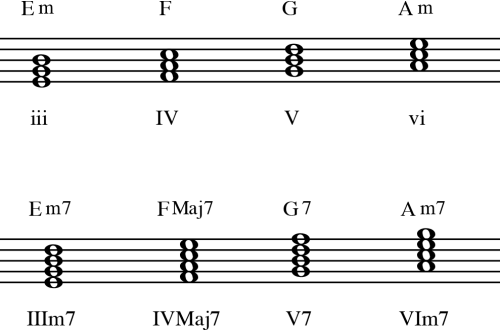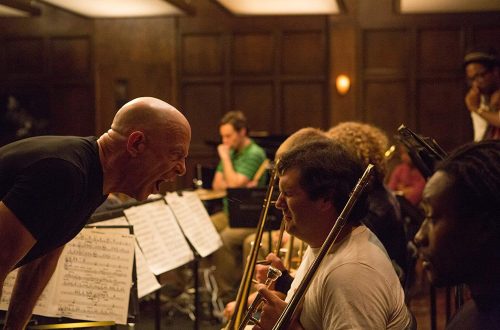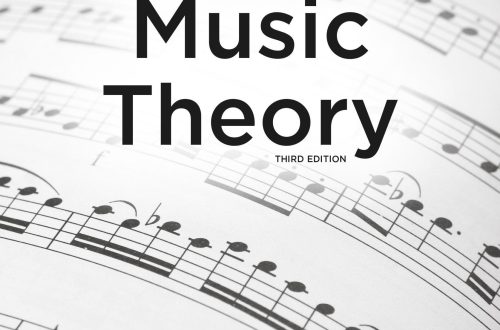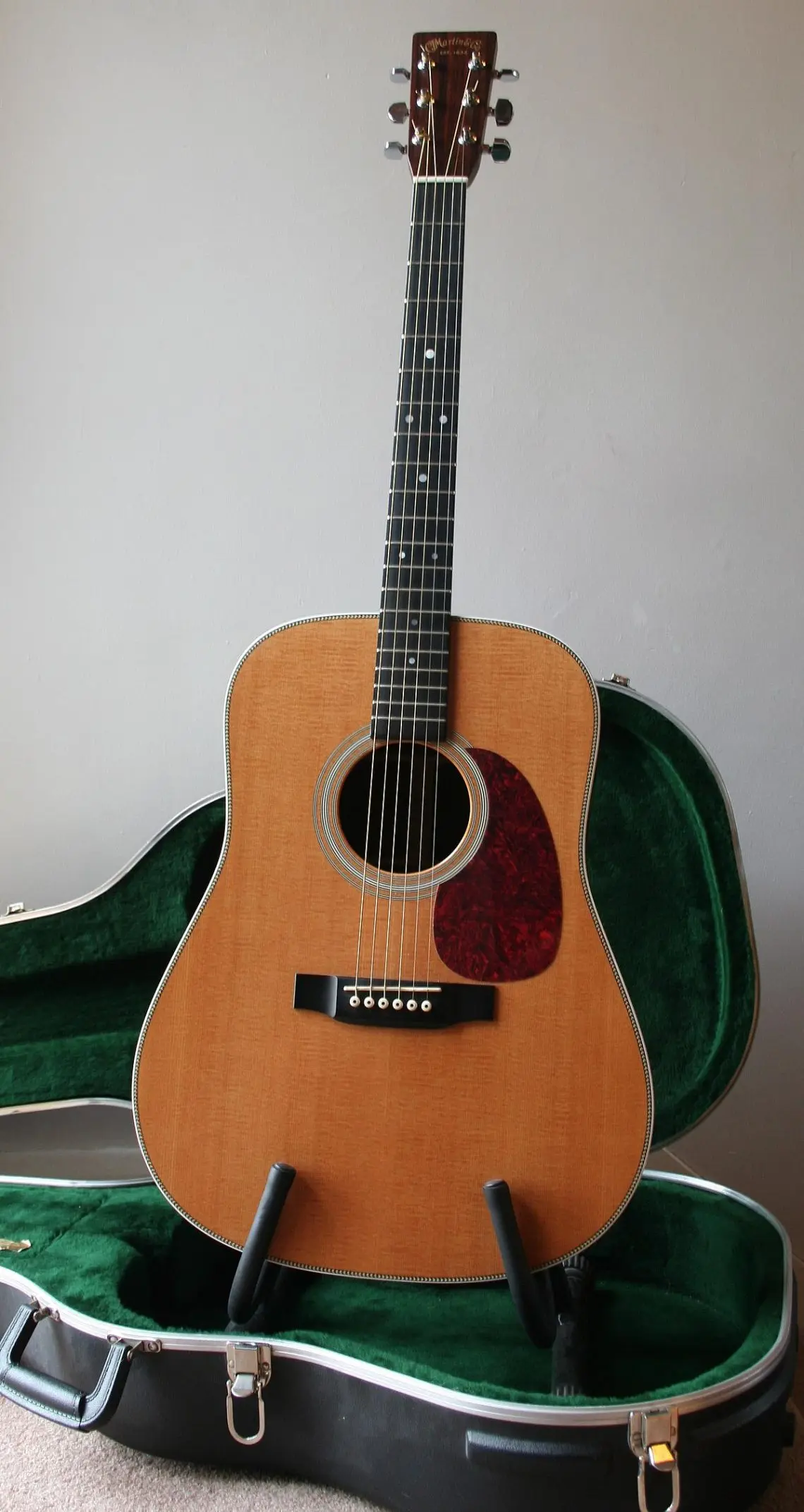
Musical size: its types and designations
Contents
Today we will talk about the musical size – the numerical expression of the meter, as well as how to count and conduct in various meters, but first we will repeat a little what pulse, meter, strong and weak beats are.
In the previous issue, we already talked about the fact that the basis of music is a uniform pulsation. Pulse beats can be strong and weak, and strong and weak beats alternate not at random, but in some strict pattern.
The most common alternation sequences are: 1 strong hit, 1 weak or 1 strong and 2 weak. For convenience, the pulse beats are recalculated (calculated for the first-second or the first-second-third, as in a physical education lesson). And each strong blow is the first. Depending on the number of weak beats, the count is kept up to two, up to three, or up to another value, until a strong time comes again. Such a count of beats (they are also called shares) is called musical meter.
Suppose that the pulse beats in quarter notes, let’s try to depict its beat in a rhythmic musical notation. In the figure below, all beats of the pulse are represented by quarter notes. If the blow is strong, then under the note is accent sign (>), it’s like the math “greater than” sign.

The time from one downbeat to the onset of the next downbeat in music is called tact, the beats are separated, that is, they are delimited from each other barline. Thus, the bar line is always located before the strong beat, which means that each new measure begins with the count of “ones” (that is, from the first, strong beat).
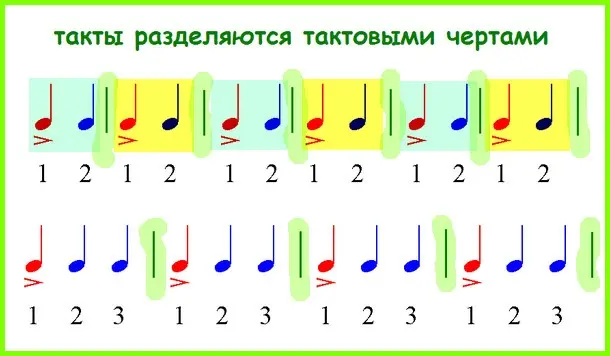
What are meters and measures?
Meters or measures are simple and complex. Simple – These are two-part and three-part. BUT complex – these are those that consist of two or more simple ones. Moreover, both homogeneous meters (for example, two triples or two doubles) and heterogeneous meters (double and triple are mixed) can be connected.
What is musical scale?
time signature is the numerical expression for a meter. Time signature measures the fullness of the measures (in other words: how many notes should fit in one measure, in one “box”). The size is usually written in the form of two numbers, which, like a mathematical fraction, are located one above the other, only without a dash (without a division sign). You can see examples of such entries in the figure:
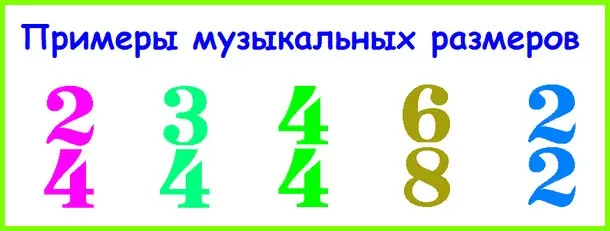
What do these numbers mean?
top number says about how many beats are in a measure, that is, how many to count (up to two, up to three, up to four, up to six, etc.). The top number should be pronounced when reading as a numeral in the feminine and nominative case (that is, two, three, four, five, etc.)
bottom number shows the duration of each beat, that is, which notes we should consider and which notes the pulse generally beats (quarter notes, half notes, eighth notes, etc.). The lower number when reading the time signature should be pronounced not as a numeral, but as the name of the corresponding musical duration in the genitive case.
Examples of correct size names: two quarters, three quarters, three eighths, four quarters, six eighths, three second (half – here is an exception to the rule), five quarters, etc.
Simple time signatures
Simple musical sizes are formed with a simple meter, that is, these sizes will also be either double or triple. Examples of simple sizes: two second, two quarter, two eighth, two sixteenth, three second, three quarter, three eighth, three sixteenth, etc.
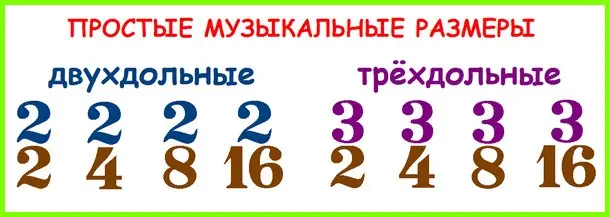
Size 2/4 “two quarters” – this is a time signature in which there are two beats and each beat is equal to one quarter note. The score is kept “one-and-two-and.” This means that two quarter notes are placed in each measure (no more and no less). But these quarter notes, or rather their sum, can be “scored” with different durations. For example, one of the shares or even both at once can be split into eighths or sixteenths (it can be in different combinations), it can be split into triplets and quintuplets. You can also, on the contrary, not split, but combine two quarters into one half, you can enter notes with dots using signs that increase the duration of the notes.
There can be a lot of options for a rhythmic pattern in a two-quarter measure. Let’s see some of them.

Size 3/4 “three quarters” – it has three beats, and each is equal to one quarter note. The score is “one-and, two-and, three-and.” The sum of three quarters can also be dialed in different ways. If, for example, you combine all three quarter notes into one note, you get a half note with a dot – this is the longest note that can be written in a measure with a given time signature. See some rhythm fill options for this time signature.

Size 3/8 “three eighths” – it looks like three-quarters in its three-part, only here the duration of each beat here is an eighth, not a quarter. The score is “one-two-three”. Eight is the main duration, but it can be divided into sixteenths if necessary, or combined into quarters (if two eighths are connected) or quarters with a dot (three eighths are connected at once). Common variants of rhythmic filling:

Complex musical time signatures
The most commonly found complex meters in music are four quarters and six eighths. Each of them consists of two simple ones.
Size 4/4 “four quarters” – contains four beats, and the duration of each beat is one quarter note. This size was formed from the sum of two simple sizes 2/4, which means that it has two accents – on the first share and on the third. The first part is called strong, and the third, which corresponds to the beginning of the second simple size, is called relatively strongwhich is weaker than strong. Additionally, let us know that 4/4 time signature is sometimes also indicated by a sign similar to the letter C (open circle).
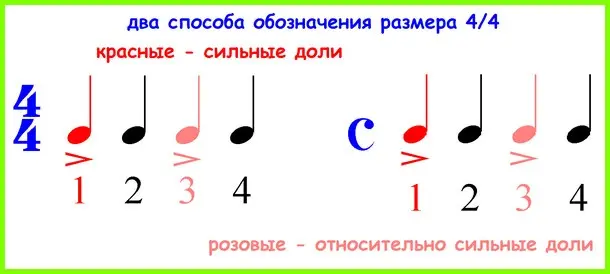
 Size 6/8 “six eighths” – this is a six-beat measure, it is composed of two simple three-beat, the pulsation goes in eighth notes. The strong beat is the first in it, and the relatively strong beat is the fourth (the beginning of the second simple time signature is 3/8).
Size 6/8 “six eighths” – this is a six-beat measure, it is composed of two simple three-beat, the pulsation goes in eighth notes. The strong beat is the first in it, and the relatively strong beat is the fourth (the beginning of the second simple time signature is 3/8).
In addition to these most common complex sizes, the musician may meet others similar to them: 4/8, 6/4, 9/8, 12/8. All these complex dimensions are formed according to a similar principle. For example, time signature 9/8 is three measures of 3/8 added together, 12/8 is four of the same connected simple measures.
mixed sizes
Mixed complex sizes are formed when not the same, but different simple ones are connected together, for example, a two-part with a three-part. Of the variety of mixed sizes, four stand out, which catch the eye more often than others. These are 5/4 and 5/8, as well as 7/4 and 7/8. From time to time, a musician may come across a meter 11/4, but this is very rare (for example, in the final chorus “Light and Power” from the opera “The Snow Maiden” by N.A. Rimsky-Korsakov).
Sizes 5/4 and 5/8 (“five quarters” and “five eighths”) – five beats, they are based on the same principle, only in one case the pulsation goes in quarter durations, and in the other – in eights. Since these sizes are complex, they consist of two simple ones – two-part and three-part. Moreover, variants of these sizes are possible, depending on the order of the simple ones.
 For example, if 5/4 goes first in 2/4, and then 3/4, then the relatively strong beat falls on the third beat. But if in the same measure a three-part is first set, and after two-part, then in this case a relatively strong beat will already fall on the fourth beat, thus one accent will be shifted, and this will change the entire internal rhythmic organization in the measure.
For example, if 5/4 goes first in 2/4, and then 3/4, then the relatively strong beat falls on the third beat. But if in the same measure a three-part is first set, and after two-part, then in this case a relatively strong beat will already fall on the fourth beat, thus one accent will be shifted, and this will change the entire internal rhythmic organization in the measure.
In order for the performer to know which version of the mixed time signature he will have to deal with, in the notes, next to the set time signature, it is often indicated in brackets which simple meters it is composed of. According to the presented sum of sizes, it is usually clear what comes first – 2/4 or 3/4. For example: 5/4 (2/4 + 3/4) or 5/4 (3/4 + 2/4). The same applies to size 5/8.
 Sizes 7/4 and 7/8 – are composed of three simple ones, one of which is tripartite, and the remaining two are two-part. Such a time signature can most often be seen in arrangements of Russian folk songs, sometimes also in instrumental music by predominantly Russian composers.
Sizes 7/4 and 7/8 – are composed of three simple ones, one of which is tripartite, and the remaining two are two-part. Such a time signature can most often be seen in arrangements of Russian folk songs, sometimes also in instrumental music by predominantly Russian composers.
Variants of the addition of the seven-beat measure differ in the position of the three-beat meter (more often it is located either at the beginning or at the end of the bar, much less often in the middle).
We have analyzed the main musical scales. As in any business, it was important to understand the principle here, then when you meet with some unusual size, you will not get lost. However, if there are still things that you have not figured out, then write your questions in the comments. Perhaps they will help to significantly improve this material.



